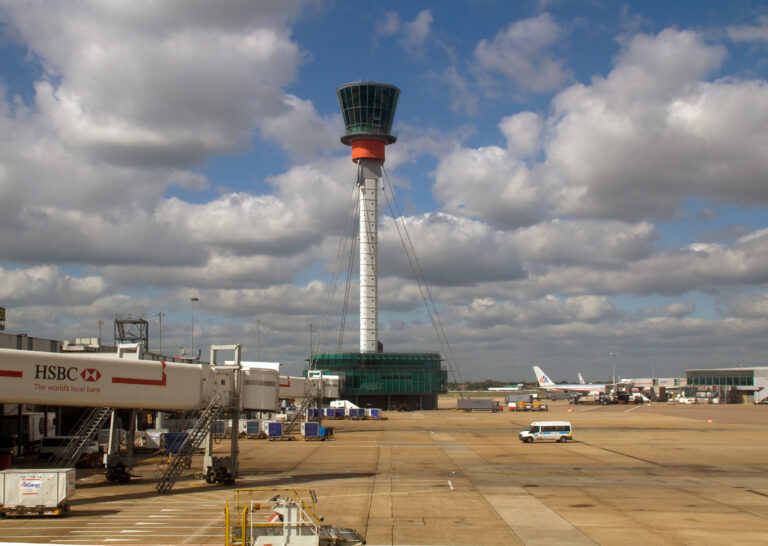As Chancellor Rachel Reeves sets out ambitious plans for a third runway at London’s Heathrow Airport, promising completion within a decade, her vision marks the latest chapter in nearly a century of engineering innovation at Britain’s busiest airport.
Last month’s announcement, which aims to increase Heathrow’s passenger capacity from its current 83.9 million to potentially 140 million annually, has sparked both excitement and scepticism among industry experts and environmental groups.
Reeves’ timeline for the expansion—to break ground during the current Parliament and see planes take off by 2035—has drawn particular attention. While some, including Ryanair’s Michael O’Leary, dismiss these targets as overly optimistic, suggesting completion might not come until 2040, the chancellor’s commitment to streamlining planning processes and overcoming potential judicial reviews reflects a determined approach to infrastructure development.
The proposed expansion faces familiar challenges that have defined Heathrow’s development since its inception in 1929.
The airport’s history of engineering solutions, particularly in dealing with London’s notorious clay soil and complex drainage requirements, provides crucial context for understanding the scale of the current proposal. Each primary development phase at Heathrow has required innovative approaches to construction, environmental management, and operational efficiency.
The timing of this expansion push coincides with significant changes in aviation technology. Reeves points to advances in sustainable aviation fuel and more efficient aircraft engines as game-changers that could help address environmental concerns. However, current supplies of sustainable aviation fuel remain limited, making up just a fraction of current fuel usage, and questions persist about scaling up production to meet the government’s ambitious mandates.
Looking back at Heathrow’s engineering history, it becomes particularly relevant as planners face the complex task of integrating a third runway into an intricate infrastructure system. Previous developments, from the post-war expansion to the construction of Terminal 5, have demonstrated how engineering solutions at Heathrow often pioneer new approaches to airport construction worldwide. The proposed third runway project must solve traditional engineering challenges and address modern demands for sustainability and environmental protection while maintaining the airport’s operations throughout construction.
As debates continue over the feasibility of Reeves’ timeline and the project’s environmental impact, understanding Heathrow’s history of engineering innovation provides valuable insights into how modern challenges might be approached and overcome in this latest ambitious expansion plan.
The History of Heathrow Airport
The story of Heathrow’s engineering development begins in 1929 on a patch of land characterized by its challenging clay soil composition. The site, originally known as the Great West Aerodrome, presented engineers with their first significant challenge: creating stable ground conditions on London clay, a material known for its poor drainage and instability when wet.

The initial engineering work focused on fundamental soil mechanics. Engineers implemented a systematic approach to ground preparation, beginning with extensive soil surveys to understand the clay’s bearing capacity and drainage characteristics. This research led to developing a pioneering drainage system that would influence future airport construction projects worldwide.
The drainage solution involved creating a network of gravel-filled trenches in a herringbone pattern. These trenches served dual purposes, providing adequate water management while creating stable foundations for the first bare runway surfaces. Water percolated through progressively finer grades of stone, preventing the clay from becoming waterlogged – a simple but effective solution that demonstrated early innovation in airport engineering.
Construction of the first runways introduced early aviation engineering concepts. Unlike modern concrete runways, these early surfaces comprised compressed gravel and crushed stone. The engineering team developed specific compaction techniques to create surfaces firm enough for light aircraft while maintaining adequate drainage. The runway design included subtle gradients, typically 1:60, to aid water runoff without affecting aircraft operations.
The outbreak of World War II accelerated development, requiring rapid adaptation of existing infrastructure. Engineers faced the challenge of strengthening runways to support heavier military aircraft while maintaining quick construction times. This led to innovations in rapid-setting concrete mixtures and developing pre-cast runway sections that could be quickly installed.
The wartime period also saw the introduction of early airport lighting systems. Engineers designed robust, low-level lighting that could withstand aircraft loads while providing crucial visibility for night operations. These systems required careful integration with the existing drainage infrastructure, leading to the development of watertight electrical conduit systems that would influence future airport electrical engineering.
The development of Heathrow’s Modern Infrastructure (1945-1960)
The transition to civilian use in 1946 marked the beginning of systematic engineering development at Heathrow. The immediate post-war period required rapid adaptation of military infrastructure to civilian needs, presenting engineers with complex airport design and construction challenges.

Aerial photograph of Heathrow Airport, 1955
The first permanent terminal, completed in 1951, introduced innovative prefabricated construction techniques. A modular building system using standardized steel components could be assembled quickly while maintaining structural integrity. This approach reduced construction time by 40% compared to traditional methods and established new standards in airport terminal construction.
Runway development during this period marked a significant advance in civil engineering. The new concrete runway system incorporated newly developed air-entraining agents, improving freeze-thaw resistance and overall durability. Engineers specified a minimum compressive strength of 4,000 psi (27.6 MPa), setting new standards for runway construction. The pavement design included expansion joints every 20 meters, with dowel bars ensuring load transfer between slabs while allowing thermal movement.
Underground infrastructure saw equally essential developments. Engineers designed an integrated fuel distribution system using a network of pressurized pipelines. Double-walled pipes with leak detection systems monitored fuel movement, while cathodic protection prevented corrosion. Remote monitoring capabilities and emergency shutdown systems ensured safe operation.
The period also saw the introduction of the first automated baggage-handling systems. Engineers developed conveyor systems using electric motors with variable speed drives, allowing baggage flow rates to be adjusted based on demand. Mechanical sensors routed bags between different terminals, marking the beginning of airport automation.
Heathrow Modern Terminal Engineering (1961-1990)
The 1960s marked a transformative period in Heathrow’s development. Terminal 3’s construction in 1961 introduced engineering concepts defining modern airport design. The terminal’s development challenged traditional approaches to structural design, passenger flow management, and systems integration.
Terminal 3’s most significant engineering achievement lay in its innovative roof design. Engineers implemented prestressed concrete technology, creating larger spans without intermediate supports. This system employed high-strength steel cables tensioned after the concrete cured, increasing load-bearing capacity while reducing structural depth. The result was more flexible interior spaces, crucial for adapting to changing passenger needs.
The engineering team developed a revolutionary multi-level approach to terminal design, separating departing and arriving passengers vertically rather than horizontally. This required new thinking about structural floor systems capable of handling variable loads. The solution involved integrating escalator and elevator systems into the building’s core while maintaining clear span areas for customs and immigration.

Heathrow Control Tower
Air traffic control systems underwent significant advancement during this period. Engineers developed an integrated approach to runway management that combined radar systems with weather monitoring. Early computer-aided landing systems improved safety and efficiency, while automated weather reporting systems provided real-time data to pilots and controllers.
The baggage handling system marked a step change in airport automation. Electric motors with variable frequency drives powered conveyor systems, while photoelectric sensors detected and routed bags. Early programmable logic controllers managed the system, representing the first steps toward fully automated baggage handling.
Terminal 5: Engineering Innovation (1991-2010)
Terminal 5’s construction represents one of the most significant infrastructure projects in the UK. The project required innovative approaches to every aspect of construction, from foundation design to roof engineering. The terminal’s size and complexity pushed engineers to develop new solutions to old problems.

The foundation system addressed London Clay’s challenging soil conditions through an integrated approach to ground engineering. Engineers designed piled foundations extending to stable soil layers, while raft foundations distributed structural loads evenly. Ground improvement techniques stabilized the soil and comprehensive waterproofing systems protected underground structures.
The structural steel frame introduced new approaches to large-span construction. Computer-optimized truss designs maximized efficiency while minimizing material use. Moment-resisting connections provided stability against wind loads while combining factory-welded sections and on-site bolted connections accelerated construction.
The terminal’s glazing system solved multiple engineering challenges simultaneously. Double-glazed units with solar control managed heat gain while maintaining transparency. Structural silicone glazing techniques eliminated the need for external frames, creating a cleaner aesthetic while maintaining structural integrity. The system had to accommodate significant thermal movement while resisting high wind loads.
Transportation integration required extensive underground construction. A rail station beneath the terminal connects to London’s transport network, while automated people mover systems transport passengers between terminals. Service tunnels house utilities and baggage systems, creating an invisible infrastructure network beneath the terminal.
Recent Developments and Future Engineering Challenges (2011-Present)
Current engineering projects at Heathrow focus on integrating sustainable technology while increasing capacity. This dual challenge has driven innovation in construction methods and systems design. Engineers face the complex task of modernizing a functioning airport while maintaining continuous operations.
Recent tunnel engineering work demonstrates this complexity. Engineers developed new methods for constructing underground linkages between terminals, using ground-freezing techniques to stabilize soil during excavation. This approach minimizes surface disruption while allowing construction to proceed beneath active taxiways.
The implementation of new air traffic management systems has transformed runway operations. Engineers have integrated artificial intelligence into runway scheduling, optimizing aircraft movements to reduce fuel consumption and noise. This system processes real-time data from multiple sources, adjusting flight patterns based on weather conditions, air traffic density, and ground operations.
Surface water management represents another area of significant engineering advancement. The airport’s new sustainable drainage system mimics natural water flows, using engineered reed beds and retention ponds to clean and slow water movement. This system can handle extreme rainfall events while reducing the environmental impact on local waterways.
Energy infrastructure has undergone substantial modernization. Engineers have developed an innovative grid system that manages power distribution across the airport, integrating renewable energy sources with traditional supply. The system includes energy storage capabilities, allowing the airport to balance load demands and reduce peak consumption.
Modern airport engineering at Heathrow increasingly focuses on environmental impact mitigation. Water recycling systems now process up to 85% of the airport’s non-potable water requirements. Engineers designed a closed-loop system that captures, treats, and redistributes water for cooling towers, toilet flushing, and landscape irrigation.
Noise reduction engineering has advanced significantly. New sound barriers incorporate active noise cancellation technology, while modified approach paths reduce aircraft noise over residential areas. Engineers developed these solutions through computational fluid dynamics modelling, optimizing barrier shapes and locations for maximum effectiveness.
Air quality management systems monitor and control emissions across the airport. Engineers designed a network of sensors that track pollutant levels in real time, allowing automated adjustments to ventilation systems. This data also informs aircraft taxiing patterns to minimize ground-level emissions.

Rendering of Heathrow with its proposed third runway. (Heathrow Airport)
Building management systems now integrate multiple environmental controls. Engineers developed a central platform that monitors and adjusts heating, cooling, lighting, and ventilation based on occupancy patterns and environmental conditions. This system reduces energy consumption while maintaining passenger comfort.
These engineering solutions represent an ongoing evolution in airport design. Future challenges include adapting to electric aircraft, managing autonomous ground vehicles, and reducing environmental impact. Engineers continue to develop new approaches to these challenges, building on decades of innovation at Heathrow.
The engineering history of Heathrow Airport demonstrates how infrastructure can evolve to meet changing demands. Each development phase has contributed to our understanding of airport engineering, from its beginnings as an austere airfield to its current status as a central international hub. Heathrow’s engineering solutions will likely influence airport design worldwide as aviation technology advances.
TLDR:
- Heathrow evolved from a small airfield to a significant international hub
- Each development phase pioneered new engineering solutions
- Terminal 5 represents modern airport engineering capabilities
- Current focus on sustainable infrastructure and environmental management







